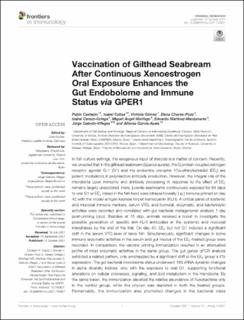| dc.contributor.author | Castejon, Pablo | |
| dc.contributor.author | Cabas, Isabel | |
| dc.contributor.author | Gomez, Victoria | |
| dc.contributor.author | Chave-Pozo, Elena | |
| dc.contributor.author | Moriñigo, Miguel Angel | |
| dc.contributor.author | García-Ayala, Alfonsa | |
| dc.contributor.author | Galindo-Villegas, Jorge | |
| dc.contributor.author | Cerezo-Ortega, Isabel | |
| dc.contributor.author | Martínez-Manzanares, Eduardo | |
| dc.date.accessioned | 2021-11-15T13:50:11Z | |
| dc.date.available | 2021-11-15T13:50:11Z | |
| dc.date.created | 2021-09-15T17:40:22Z | |
| dc.date.issued | 2021 | |
| dc.identifier.citation | Castejón, P., Cabas, I., Gómez, V., Chaves-Pozo, E., Cerezo-Ortega, I., Moriñigo, M. A., Martinez-Manzanares, E., Galindo-Villegas, J. & García-Ayala, A. (2021). Vaccination of gilthead seabream after continuous xenoestrogen oral exposure enhances the gut endobolome and immune status via GPER1. Frontiers in Immunology, 12: 742827. doi: | en_US |
| dc.identifier.issn | 1664-3224 | |
| dc.identifier.uri | https://hdl.handle.net/11250/2829635 | |
| dc.description.abstract | In fish culture settings, the exogenous input of steroids is a matter of concern. Recently, we unveiled that in the gilthead seabream (Sparus aurata), the G protein-coupled estrogen receptor agonist G-1 (G1) and the endocrine disruptor 17α-ethinylestradiol (EE2) are potent modulators in polyreactive antibody production. However, the integral role of the microbiota upon immunity and antibody processing in response to the effect of EE2 remains largely unexplored. Here, juvenile seabreams continuously exposed for 84 days to oral G1 or EE2 mixed in the fish food were intraperitoneally (i.p.) immune primed on day 42 with the model antigen keyhole limpet hemocyanin (KLH). A critical panel of systemic and mucosal immune markers, serum VTG, and humoral, enzymatic, and bacteriolytic activities were recorded and correlated with gut bacterial metagenomic analysis 1-day post-priming (dpp). Besides, at 15 dpp, animals received a boost to investigate the possible generation of specific anti-KLH antibodies at the systemic and mucosal interphases by the end of the trial. On day 43, EE2 but not G1 induced a significant shift in the serum VTG level of naive fish. Simultaneously, significant changes in some immune enzymatic activities in the serum and gut mucus of the EE2-treated group were recorded. In comparison, the vaccine priming immunization resulted in an attenuated profile of most enzymatic activities in the same group. The gut genes qPCR analysis exhibited a related pattern, only emphasized by a significant shift in the EE2 group’s il1b expression. The gut bacterial microbiome status underwent 16S rRNA dynamic changes in alpha diversity indices, only with the exposure to oral G1, supporting functional alterations on cellular processes, signaling, and lipid metabolism in the microbiota. By the same token, the immunization elevated the relative abundance of Fusobacteria only in the control group, while this phylum was depleted in both the treated groups. Remarkably, the immunization also promoted changes in the bacterial class Betaproteobacteria and the estrogen-associated genus Novosphingobium. Furthermore, systemic and mucosal KLH-specific immunoglobulin (Ig)M and IgT levels in the fully vaccinated fish showed only slight changes 84 days post-estrogenic oral administration. In summary, our results highlight the intrinsic relationship among estrogens, their associated receptors, and immunization in the ubiquitous fish immune regulation and the subtle but significant crosstalk with the gut endobolome. | en_US |
| dc.language.iso | eng | en_US |
| dc.publisher | Frontiers | en_US |
| dc.rights | Navngivelse 4.0 Internasjonal | * |
| dc.rights.uri | http://creativecommons.org/licenses/by/4.0/deed.no | * |
| dc.title | Vaccination of gilthead seabream after continuous xenoestrogen oral exposure enhances the gut endobolome and immune status via GPER1 | en_US |
| dc.type | Peer reviewed | en_US |
| dc.type | Journal article | en_US |
| dc.description.version | publishedVersion | en_US |
| dc.rights.holder | © 2021 The Author(s) | en_US |
| dc.subject.nsi | VDP::Landbruks- og Fiskerifag: 900::Fiskerifag: 920::Fiskehelse: 923 | en_US |
| dc.source.volume | 12 | en_US |
| dc.source.journal | Frontiers in Immunology | en_US |
| dc.identifier.doi | 10.3389/fimmu.2021.742827 | |
| dc.identifier.cristin | 1934667 | |
| dc.source.articlenumber | 742827 | en_US |

